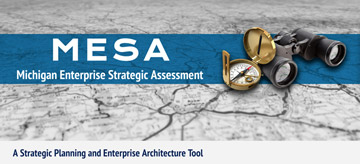 U-M’s Michigan Enterprise Strategic Assessments, better known as MESAs, are making a splash here and at other universities.
U-M’s Michigan Enterprise Strategic Assessments, better known as MESAs, are making a splash here and at other universities.
The MESA is a strategic planning tool created and launched in summer 2015 by the ITS Enterprise Architecture team. Groups and teams start with a template and through a series of directed discussions build their own MESA. The outcome is a document or set of documents and corresponding artifacts that help those teams visually express their strategic goals, plans to achieve those goals, and the current and desired future state of their services, products, technologies, or capabilities.
Broad appeal
The MESA presentation by U-M and early adopter Yale University at Educause 2016 resulted in a flurry of inquiries and discussions with folks from several institutions, including Arizona State University, the University of Minnesota, and the University of Washington. “Kyoto University is hoping to have someone from U-M visit and speak with their leaders,” says Chris Eagle, IT strategist and enterprise architect, Office of the VPIT-CIO. “We’ve noticed that when we speak about MESAs in forums and at conferences, individuals are quick to recognize the tool’s benefits and the significant value it can bring to their organizations.”
MESAs use a consistent format across all organizational levels, looking forward three years. It is this standardization that allows staff to view and familiarize themselves with each team’s thinking. As more teams build and publish MESAs, their institutions amass a better sense of what individual and collective teams are thinking and planning. What’s more, the information included in the documents can be used to align team decisions with institution-wide strategic plans.
Wide-ranging benefits
“We’ve noticed that when we speak about MESAs in forums and at conferences, individuals are quick to recognize the tool’s benefits and the significant value it can bring to their organizations.”
— Chris Eagle, ITS
Advocates say that the formal exercise assisted with determining what capabilities should be pursued or abandoned. Team discussions offered a chance to develop long-term vision documents that could be referenced easily.
“ITS teams have been building and using MESAs for over a year now,” says Dan Kiskis, enterprise architect, Office of the VPIT-CIO. “Entering the annual review process, we interviewed directors and managers about the tool’s effectiveness. They conveyed that it helps them think strategically about their services and roadmaps. Others pointed out that they began exploring technologies their teams might not otherwise have considered.”
As MESA usage weaves its way through the Michigan IT community, more teams on the Ann Arbor, Dearborn, and Flint campuses, and the Health System have an opportunity to show the intent and aspirations of their services. They can plan how best to maintain existing business processes and implement new business processes that are dependent on certain IT services. The result is a transparent and bite-sized strategic plan that can be mutually beneficial for IT service providers and customers.
Individuals and teams can find out more about this useful tool by visiting the MESA website. General inquiries or presentation requests should be sent to umich-ea@umich.edu.
